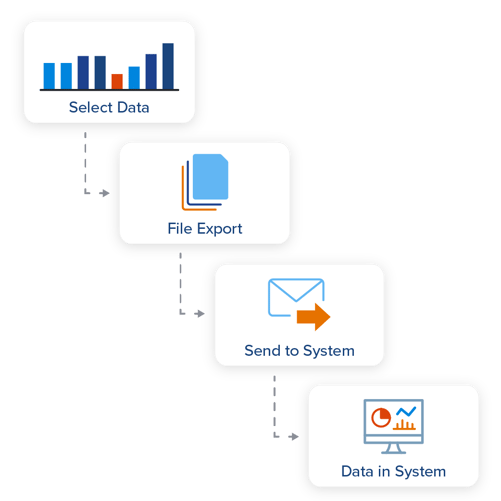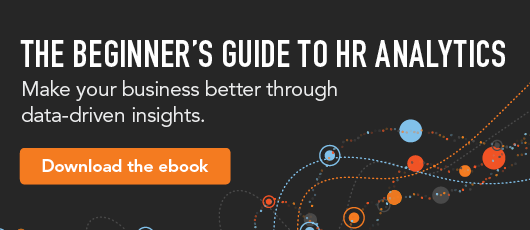HR Analytics Tools: The Application of HR Analytics at Your Organization
 HR leaders are increasingly dependent on employee data to shape their people and business decisions. Gone are the days of using gut feelings to develop business decisions—successful leaders leverage reliable, evidence-based data to define their business strategy. In fact, almost 70% of HR leaders use HR analytics in some way.
HR leaders are increasingly dependent on employee data to shape their people and business decisions. Gone are the days of using gut feelings to develop business decisions—successful leaders leverage reliable, evidence-based data to define their business strategy. In fact, almost 70% of HR leaders use HR analytics in some way.
But still, some leaders don’t have the background they need about HR and people analytics to apply it at their organization. This guide will help you understand:
- What HR analytics is
- How employee data can benefit your organization,
- Best practices for implementing a successful HR analytics strategy
- What to look for in HR analytics software
![[FREE DOWNLOAD] The Beginner's Guide to HR Analytics: The What, Why, and How of HR Analytics](https://no-cache.hubspot.com/cta/default/99128/3dfd3ec6-e9d8-4d30-99e3-4305a6021275.png)
What is HR analytics
HR analytics is the data you collect about your people. This process involves gathering, analyzing, and connecting talent data to business outcomes. The insight leaders uncover with HR analytics provides the evidence needed to take strategic action. With a robust HR analytics strategy, leaders can make data-driven decisions and move forward with confidence.
HR analytics vs. people analytics
HR analytics and people analytics are often used interchangeably but there are slight differences between these terms based on the data they measure. HR analytics deals primarily with the function of HR. It measures metrics such as time and cost to hire, train, and promote employees. People analytics, however, is a broader term that can also involve data about people outside your organization too, like customers.
What does HR analytics measure
HR analytics can measure many things that are key to business success. With a robust strategy and the right tools, leaders can keep a pulse on:
- Employee engagement
Your employees are a top driver of business success—that’s why leaders need to keep a pulse on employee engagement levels across their workforce. By uncovering engagement trends over time, leaders can gauge where employee engagement stands. That way, they can understand what areas of the employee experience to focus on. And when leaders connect employee engagement data to business outcomes, they can tell compelling stories about their people and take strategic action to shape an engaged, motivated workforce. - Employee performance
HR analytics can help leaders understand performance impact across all individuals and teams. See the big picture behind employee performance to address skills gaps, motivate rising stars, and drive long-term business success. - Voluntary and involuntary turnover rate
Keeping a pulse on both your involuntary and voluntary turnover rates gives insight into the employee experience and the success of your recruiting strategy. If many employees choose to leave within a given time period, leaders should find ways to improve the employee experience. If many employees are being terminated from their roles, it’s time to evolve your recruiting strategy. - Turnover risk
Turnover risk identifies employees at risk for leaving their organization based on metrics such as absenteeism rates, performance issues, and low engagement levels. This predictive data helps leaders take measures to prevent talent loss before it’s too late and retain valued employees. - Human capital risk
Human capital risk helps leaders keep a pulse on all employee-related risks. These include employee skills gaps and lack of employees to fill senior positions. When you understand the scope of these employee-related risks, you can take the action needed to mitigate threats and move forward with confidence. - Training efficiency
Based on employee performance, role progression, and employee growth after training, leaders can understand what’s working and what isn’t in their training program. If your training program fails to set employees up for success, performance suffers and revenue plummets. To put your best foot forward for employee and business success, leaders need a constant pulse on training efficiency. - Absenteeism
Absenteeism rates measure the number of days that an employee missed over a period of time. This gives insight into employee productivity and happiness. If many employees have high absenteeism, the employee experience may be lacking. - Revenue and training expenses per employee
When you divide your organization’s generated revenue by each employee, you can understand the average revenue that each employee produces. This gives leaders insight into the efficiency of revenue generation through employees. - Time to hire and fill
The time to hire an employee measures the number of days between approaching a future employee and their acceptance of your offer. Time to fill measures the average number of days between publicizing a job opening and finding someone to fill that role. Time to fill and time to hire data helps leaders uncover gaps in their recruiting process, improve the candidate experience, and reduce the amount of time it takes to hire solid employees. - Offer acceptance rate
Your offer acceptance rate gives insight into your talent acquisition strategy’s success. It’s measured by dividing the number of accepted job offers within a given period by the total number of job offers. By keeping a pulse on this data point, you’ll know when it's time to adapt and improve your strategy.
Why does your business need HR analytics
The deep insights leaders uncover with HR analytics helps shape meaningful action. Here are the top benefits of using HR analytics to make strategic decisions:
- Reduce employee turnover
- Enable fast, strategic recruiting
- Understand effectiveness of training and development
- Develop long term hiring plans
- Understand and act on employee perceptions
- Identify high performers and skills gaps
Tips for getting started with HR analytics
Getting started with an HR or people analytics strategy can seem difficult, especially when leaders have little experience with the process. To ensure your program is successful, keep these tips in mind when getting started:
1. Clearly define the business problem you are trying to solve or the opportunity you want to uncover.
2. Identify your data sources and gaps, like employee surveys and industry benchmark data.
3. Use robust technology to empower your strategy.
4. Get senior leadership buy-in.
5. Leverage data engineers to track and collect quality data.
6. Slice and dice data between different demographic groups.
7. Use data experts to interpret your data and understand its full scope.
8. Use your data to implement changes across the organization.
HR analytics tools: how technology streamlines analytics
HR analytics tools empower leaders to make better people and business decisions. When searching for software to maximize your success, look for these features:
HR analytics dashboards
Dynamic analytics dashboards help leaders visualize their trends—all in one place—to tell meaningful stories about their people. With a robust intelligence dashboard, leaders can assess the relationship between engagement, performance, turnover, alignment, and varying work environments with an integrated user experience.
Plus, automated best practice configurations and visualizations provide deep insights that are tailored to your business. Custom reporting answers your unique questions and generates automated reports about your people. Your data is at your fingertips at all times in an easy to interpret manner with a robust intelligence dashboard.
Data feed
A seamless data feed helps leaders uncover deeper insights about their people by combining HR analytics with other key business analytics. It equips leaders with the context they need to make strong decisions and take needed action.
You can extract, transform, and load data in one take, and store it for future reporting needs. Plus, a strong data feed feature will update data on a frequency that best fits your organization’s needs, so that your data is always up-to-date and accurate.

Employee flight risk
Employee flight risk tools identify employees at risk of leaving your organization before they leave. This preventative tool helps leaders shape better retention strategies and prevent top talent loss. Leaders can reduce turnover costs and make impactful investments on retention to shape a workforce of highly-skilled talent.
Turnover trends
It’s important to understand which employee perceptions and experiences often lead to turnover. A robust HR analytics platform will tie employee survey results to turnover data, giving insight into the drivers of employee turnover. This gives leaders the data they need to shape an engaging employee experience and retain their top performers.
Text analytics
Survey text analytics helps surface key themes in your employee surveys. Qualitative employee perceptions are important to measure, but often take a lot of time to sift through. With a streamlined text analytics tool, you can take the weight off of your shoulders and quickly analyze survey comments for critical insights.
Demographics
Leaders need to be able to slice, dice, and filter data for better clarity and understanding. This helps leaders understand viewpoints based on things like tenure length, department, and role. Segmenting data helps to paint a more comprehensive, accurate picture of your workforce to shape successful business action.
To stay buoyant in an ever-changing workplace, leaders can’t shape their people and business decisions without data-based evidence. Luckily, the right tools will streamline and expedite your HR analytics strategy to uncover meaningful insights, make confident decisions, and propel long-term business success. Leverage a robust HR analytics platform to put your best foot forward and thrive in the modern workplace.
To get more background about the importance of people data—and the process to collect it—download our ebook, The Beginner's Guide to HR analytics: The What, Why, and How of HR analytics.



.png?width=501&name=Intelligence-Dashboard-1%20(1).png)



